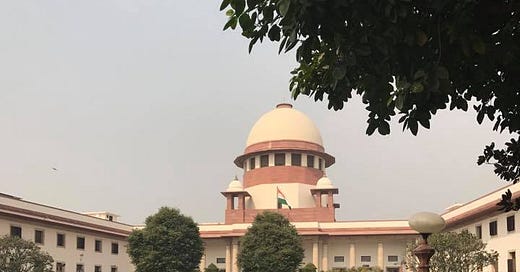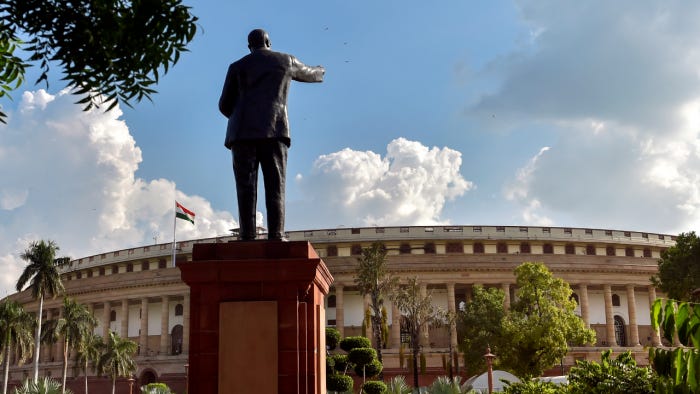Landmark Supreme Court Judgment on Sub-Classification of Scheduled Castes
Opens up scope for unending litigation between various Scheduled Castes, each claiming a bigger share in the reservation pie. The question of "creamy layer" amongst SCs also flagged.
Sub-Classification of Scheduled Castes Permissible
On August 1, 2024, the Supreme Court of India delivered a landmark judgment allowing states to sub-classify Scheduled Castes (SCs) for the purpose of reservations in government jobs and education. This significant ruling has far-reaching implications and marks a pivotal shift in India's reservation policy. While it settles the core issue of sub-classifications, it opens up numerous points of contention that will require resolution through fresh rounds of litigation, political processes, and further enactments, including constitutional amendments. Here are the key details of this judgment, which had been heard in February1:
The Judgment
A 7-judge Constitution Bench, headed by Chief Justice DY Chandrachud, ruled in a 6:1 majority that sub-classification of Scheduled Castes is permissible for providing reservations. The concerned State Government can do so, not arbitrarily, but by duly considering relevant empirical data and following a rational criteria. This is permissible notwithstanding the constitutional position that a caste in any state can be notified as a “Scheduled Caste” only by a Presidential order. The court overruled its previous 2004 judgment in the E.V. Chinnaiah vs State of Andhra Pradesh case, which had held that SCs formed a homogeneous group and could not be further sub-divided.
Main Points of the Ruling
Heterogeneity of SCs: The court held that SCs are not a homogeneous group and can be sub-classified based on varying degrees of backwardness.
Equitable Distribution: States can sub-classify SCs to ensure more equitable distribution of reservation benefits.
Data-Driven Sub-Classification: The sub-classification must be based on quantifiable and demonstrable data, not on political whims.
Article 341 Interpretation: The court emphasized that Article 341 of the Constitution does not create a "deeming fiction" that all SCs are a homogeneous class.
Creamy Layer Issue
Four of the seven judges, including Justice BR Gavai, called for the identification of a creamy layer among SCs and STs. They suggested that this creamy layer should be removed— like in the case of Other Backward Classes (OBC)— from the reservation matrix to ensure benefits reach the most disadvantaged.
Dissenting Opinion
Justice Bela M Trivedi provided the lone dissenting judgment. She argued that states cannot alter the SC list notified under Article 341 of the Constitution. Justice Trivedi contended that sub-classification would amount to tinkering with the Presidential list and could lead to a "colourable exercise of power."
Overruled Decision
The judgment overruled the 2004 decision in E.V. Chinnaiah vs State of Andhra Pradesh. The Chinnaiah judgment had held that SCs formed a homogeneous group and could not be sub-classified for reservation purposes.
Punjab Connection
a.) Punjab's Sub-Classification Act
The case originated from Punjab's attempt to sub-classify Scheduled Castes (SCs) for reservation purposes, central to which was the Punjab Scheduled Caste and Backward Classes (Reservation in Services) Act, 2006. This Act became the focal point of the legal dispute leading to the Supreme Court's landmark judgment on August 1, 2024.
b.) Key Provisions of the 2006 Punjab Act
The 2006 Act reintroduced "first preference" reservations for specific SC communities. It stipulated that 50% of the total seats reserved for SCs would be offered first to Balmikis (also known as Valmikis) and Mazhabi Sikhs before being allocated to other SC groups. This legislative effort was aimed at addressing the disparities within the SC community and ensuring that the most disadvantaged among them received the benefits of reservation.
c.) Historical Context
In 1975, Punjab had issued a notification dividing its 25% SC reservation into two categories. Half of these seats were reserved for Balmikis and Mazhabi Sikhs, while the other half was for the remaining SC groups. This notification remained in effect for 31 years, reflecting an ongoing effort to address intra-SC disparities.
d.) Legal Challenges
The legal challenges began when the 1975 notification was struck down by the Punjab and Haryana High Court in 2006, following the Supreme Court's decision in E.V. Chinnaiah v. State of Andhra Pradesh (2004). This decision held that SCs formed a homogeneous group and could not be further sub-divided. Subsequently, the 2006 Punjab Act was also struck down by the Punjab and Haryana High Court on March 29, 2010, prompting the Punjab government to appeal to the Supreme Court.
e.) Supreme Court Appeal and Outcome
The Punjab government appealed to the Supreme Court against the High Court's decision to strike down the 2006 Act. The Supreme Court's recent judgment on August 1, 2024, has upheld the validity of laws providing for such sub-classification in Punjab and other states. This ruling marks a significant shift in reservation policy, allowing for more nuanced implementation of affirmative action measures.
f.) Rationale for Sub-Classification
The Punjab government argued that sub-classification was necessary to ensure that the benefits of reservation reach the most disadvantaged groups within the SC category. The focus was on providing preferential treatment to Balmikis (Valmikis) and Mazhabi Sikhs, who were to be given first preference for 50% of the total SC quota.
Broader Implications
This judgment has broader implications beyond Punjab. It permits other states to implement similar sub-classifications within the SC category, provided they have empirical data to justify such classifications. This allows for more targeted affirmative action, ensuring that the most disadvantaged within the SC community receive the intended benefits.
In summary, the Supreme Court's ruling on August 1, 2024, marks a pivotal shift in India's reservation policy, validating the sub-classification of SCs to achieve more equitable distribution of reservation benefits. This decision not only impacts Punjab but also sets a precedent for other states to follow.
Implications
Targeted Affirmative Action: States can now create sub-categories within SCs based on relative backwardness, allowing for more targeted affirmative action to reach the most disadvantaged groups within SCs.
Empirical Justification: The ruling emphasizes the need for empirical data to justify sub-classification.
Exclusion of Creamy Layer: It opens up discussions on identifying and potentially excluding the "creamy layer" within SCs and STs from reservation benefits.
Bottom Line
The Supreme Court's ruling permits states to sub-classify Scheduled Castes already notified by the President of India, using rational criteria based on empirical data. The bench, therefore, overruled an earlier five-judge bench view that SCs notified for a particular state by the President constituted one homogeneous group, making any further classification impermissible by the state. This matter arose from disputes in various states, especially Punjab, where 50% of the seats in the SC category have been reserved for Valmikis and Mazhabis since 2006 through an act of the state legislature.
Interestingly, four of the six judges who concurred in this judgment expressed strong views that the “creamy layer” within the SC category must be excluded to ensure that the benefits of reservation percolate to the most deserving.
While the principle laid down by the Supreme Court is straightforward conceptually, it raises several complex questions:
Existing Policies: What happens to policies like Punjab's, where sub-classification has been in place since 2006? Will the state government need to justify this criteria with empirical data, and will the existing arrangement continue in the meantime? This could open another round of litigation, not on the principle of sub-classification, but on the ratios and percentages used.
Intra-SC Disputes: This judgment could engender disputes among various SC groups within a state, leading to endless litigation over which groups should receive reservation benefits based on perceived most backward or deprived social and economic status.
Percentage Limitations: The Supreme Court declared that states cannot reserve 100% of the seats for a particular SC group. Questions arise about the constitutional validity of high reservation percentages, such as 95%, for the most backward SCs after empirical data collection.
Exclusion of Creamy Layer: Observations made by the judges suggest that the creamy layer within SCs should be excluded from reservations, similar to the OBC criteria. This raises questions about whether this is a binding mandate on the Union of India and the time frame for any action.
End Note
The issue of reservations has always been contentious, encompassing provisions for economically weaker sections, particular religious minorities, the disabled, and SCs and STs as well as the OBCs. In a charged political environment, where debates on caste and caste census are already intense in the Parliament, this Supreme Court decision will have far-reaching ramifications. It may open up more disputes between SC groups within states and raise questions about whether this decision fosters unity or deepens divisions within the SC community. Whether the apex court judgment has unwittingly unleashed a “divide and rule” policy targeting the Scheduled Castes remains to be seen. Only time will reveal the true impact of this landmark ruling on the social and political fabric of India.
Citations
[1] Indian Express [2] Scroll [3] ABP Live [5] Economic Times [6] The News Minute
State Of Punjab And Ors. v Davinder Singh And Ors. C.A. No. 2317/2011






